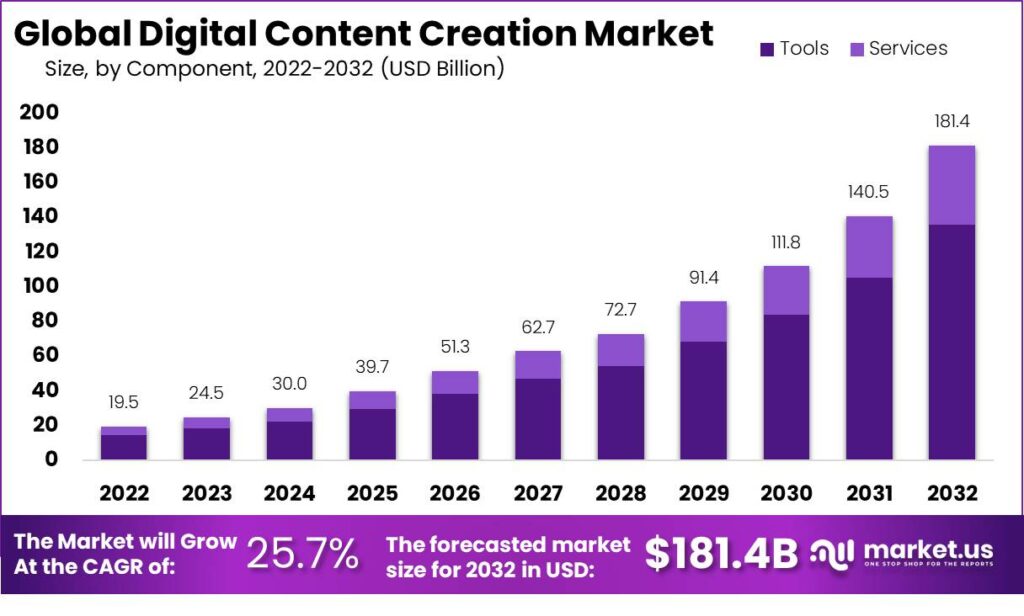
The Digital Content Creation Market: A Comprehensive Overview
Introduction:
The Digital Content Creation Market is currently experiencing a rapid and transformative evolution, driven by several key factors. This market encompasses the creation, development, and distribution of digital content in various forms, including textual, graphical, video, and audio content. In this comprehensive summary, we delve into the essential aspects of this market, from its current size and growth prospects to the major players and trends shaping its trajectory.
Market Size and Growth:
As of 2023, the Digital Content Creation Market is valued at approximately USD 24.5 billion. However, projections indicate that it is set to witness remarkable growth, with expectations of reaching a substantial valuation of around USD 181.4 billion by 2032. This growth translates to a remarkable Compound Annual Growth Rate (CAGR) of 25.7% over the forecast period from 2023 to 2032.
Key Drivers of Market Growth:
Several critical factors are propelling the growth of the Digital Content Creation Market:
1. Cost-effectiveness: Digital content creation offers a cost-effective solution for businesses and organizations to reach their target audiences, making it an attractive option.
2. Internet Penetration: Growing internet penetration rates have expanded the reach of digital content, making it accessible to a global audience.
3. Smartphone and Tablet Adoption: The increasing use of smartphones and tablets has facilitated content consumption, further boosting market demand.
4. Digital Marketing Tools: Enhanced adoption of digital marketing tools has led organizations to emphasize strategies aimed at attracting clients, driving the need for digital content creation.
Market Segmentation:
The Digital Content Creation Market is segmented into various categories:
1. By Component: This includes both Tools and Services, with the Tools segment dominating the market, accounting for 74.8% of revenue in 2022.
2. By Content: The market comprises Textual, Graphical, Video, and Audio content. Video content, in particular, holds a significant market share of 39.8% in 2022.
3. By Deployment: The market is divided into Cloud and On-Premise deployment, with the Cloud segment holding the highest market revenue share in 2022.
4. By Application: Applications include Branding & Marketing, Product Demonstration, Customer Engagement Solutions, and others. Branding and marketing recorded the largest revenue share in 2022.
5. By End-User: End-users encompass various sectors such as Retail & E-commerce, Healthcare & Pharmaceutical, Media & Entertainment, Automotive, Travel & Tourism, and others. Retail and online commerce held the highest revenue share in 2022.
Source: Digital Content Creation Market to Hit US$ 181.4 Bn in 2032 | Grow CAGR by 25.7% (Y-O-Y)
Key Trends:
Several trends are shaping the Digital Content Creation Market:
1. Video Content Surge: Video content creation is experiencing rapid growth, with platforms like YouTube, TikTok, and Instagram driving its popularity.
2. AI Integration: Artificial Intelligence (AI) is increasingly being used for creating digital media content, enhancing efficiency and quality.
3. Personalization: There is a growing need for personalized content to engage with target audiences effectively.
Major Market Players:
Key players in the Digital Content Creation Market include Adobe Inc., Google LLC, Acrolinx GmbH, Integra Software Services, Quark Software, Inc., MarketMuse, Inc., Cascade Parent Limited, Aptara Inc., Apple, Inc., and others. These companies play a pivotal role in driving market innovation and competitiveness.
Challenges:
While the Digital Content Creation Market holds substantial growth potential, it faces challenges such as copyright infringement, piracy, and the high cost of production. Monetizing digital content also poses difficulties.
Opportunities:
The primary opportunity in this market lies in its growth potential, especially considering its initial stages of development. There exists significant room for expansion over time, driven by increasing demand for engaging and informative digital content.
Conclusion:
The Digital Content Creation Market is undergoing a transformative journey, with remarkable growth prospects driven by cost-effectiveness, increasing internet penetration, and the rising demand for video content. While challenges like copyright infringement persist, opportunities abound, particularly in the realm of personalized content and AI-driven content creation. As it continues to evolve, this market promises a bright and lucrative future for businesses and organizations worldwide.


